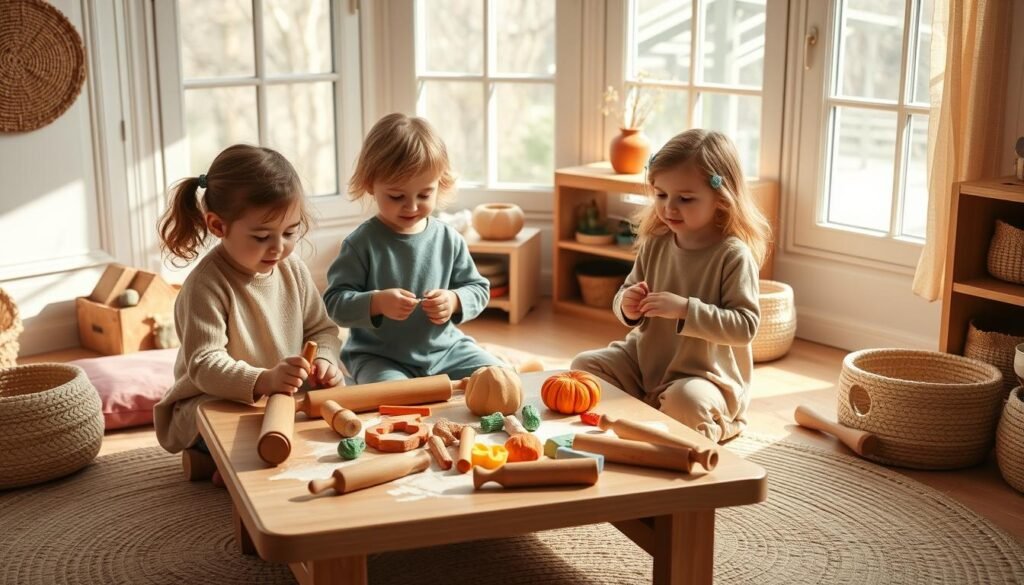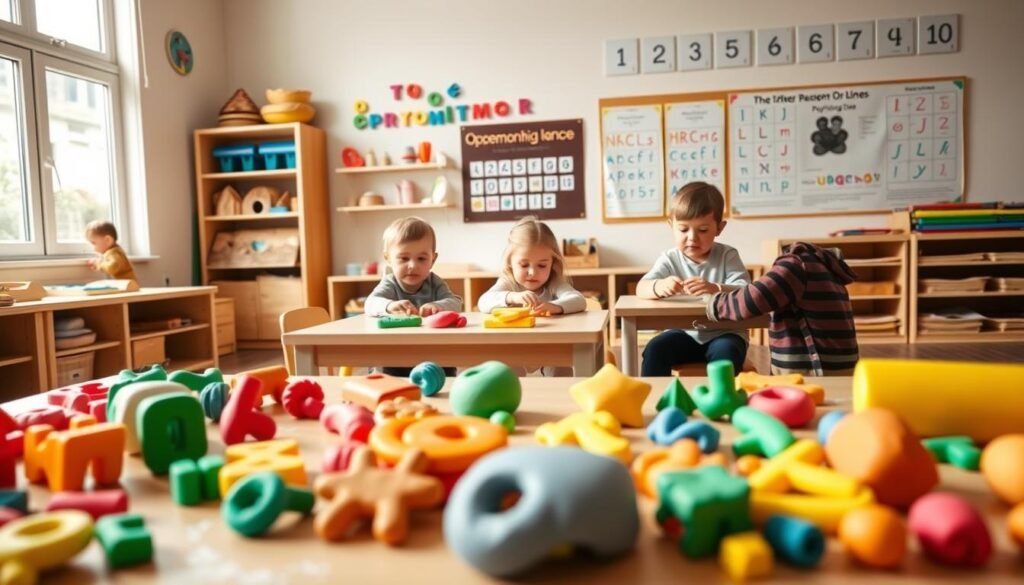
Montessori how to introduce playdough” is an essential approach to hands-on learning. Playdough is a great tool for education, turning simple play into a powerful developmental experience. When we learn how to introduce playdough in Montessori, we discover a versatile medium that engages young learners through touch and creativity.
Playdough is a great tool for learning. It turns simple play into a powerful educational experience. When we learn how to introduce playdough in Montessori, we find a versatile medium. It engages young learners through touch and creativity.
The Montessori method focuses on hands-on learning. Playdough activities for toddlers are perfect for early development. They offer structured play that lets kids develop important skills while having fun.
Sensory play has a big impact on kids. Caregivers can unlock a child’s potential with something as simple as playdough. Every action with the dough, like squeezing or shaping, helps with learning and growth.
Table of Contents
Understanding the Montessori Approach to Sensory Play
Montessori education makes learning fun by using hands-on activities. Playdough is a great way for kids to learn and grow. It lets them explore and develop important skills through touch.
The Montessori method believes kids learn best by touching and doing things. Playdough isn’t just for fun. It helps young minds grow and learn in many ways.
The Role of Hands-on Materials in Learning
Hands-on materials are key in Montessori education. They help kids:
- Get better at using their hands
- Improve how they sense things
- Make connections in their minds
- Explore on their own
Core Principles of Sensory Learning
Montessori sensory learning uses all senses at once. Playdough lets kids:
- Feel different textures
- Understand space better
- Get better at using their hands and eyes together
- Learn by doing
Benefits of Tactile Exploration
Playdough is great for kids because it helps them grow. Two-year-olds especially benefit from it. It helps their brains grow and builds the foundation for learning later on.
Children do not learn through passive observation, but through active engagement with their environment.
The Developmental Benefits of Playdough in Early Learning
Playdough is more than just fun for young kids. It’s a powerful tool for learning. It turns simple play into a chance to grow and develop in many ways.
Playdough helps kids improve their fine motor skills. They get better at using their hands by kneading, rolling, and shaping. This helps them write and do everyday tasks better.
- Enhances hand-eye coordination
- Builds finger strength
- Supports pincer grip development
- Promotes spatial awareness
Playdough also boosts brain power. Kids learn to solve problems by making new shapes and trying different ways. This makes their brains work better and helps them think creatively.
Playdough also helps kids feel better and get along with others. It’s calming and lets kids share and work together. It’s a safe space to try new things without worrying about making mistakes.
Play-based learning supports children’s holistic development across physical, cognitive, and emotional domains.
Studies show playdough is key for learning. It mixes fun with learning, making kids more confident and ready for harder challenges.
Montessori How to Introduce Playdough: A Step-by-Step Guide
Introducing playdough to preschoolers needs a careful plan. The Montessori method focuses on hands-on learning and sensory exploration. Playdough is perfect for this.
Setting up the right space is key. Make sure it’s clean, organized, and welcoming. All materials should be easy for kids to find.
Creating the Perfect Learning Space
- Choose a low table or child-sized workspace
- Use a washable mat or tray underneath
- Ensure good lighting and comfortable seating
- Keep tools within easy reach
Age-Appropriate Introduction Techniques
Start with simple, guided play when introducing playdough. Young kids do best with clear examples and gentle nudges.
- Demonstrate basic playdough manipulation
- Show rolling, squeezing, and pressing techniques
- Allow free exploration without strict expectations
- Use positive, encouraging language
First Session Tips
Your first playdough session should be short and fun. Focus on the experience, not perfection.
- Keep initial sessions brief (10-15 minutes)
- Provide multiple color options
- Introduce simple tools like plastic knives or rolling pins
- Encourage creativity and experimentation
The goal of introducing playdough in Montessori is to support natural learning. This happens through hands-on exploration and sensory play.
Essential Playdough Tools and Materials for Montessori Activities

Exploring playdough tools can change your child’s learning experience. Montessori playdough trays offer a structured way to play. They encourage kids to explore on their own and learn new skills.
When picking playdough tools, think about these important things:
- Rolling pins for texture and shape creation
- Cookie cutters in various shapes
- Plastic knives for safe cutting practice
- Textured rollers to enhance sensory engagement
- Small plastic trays for organized work stations
Montessori playdough trays help with focused learning. They are made to support kids in learning while keeping their space tidy. Each tray usually has:
- A designated work mat
- Specific playdough tools
- A small container for materials
- Clear boundaries for focused activity
Safety is key when choosing playdough tools. Look for tools that are safe for kids. Wooden tools offer a natural texture that enhances sensory exploration.
The right tools can transform playdough from a simple activity to a rich learning experience.
By using the right playdough tools, you create a space that boosts creativity, focus, and motor skills. This is all in a Montessori-inspired way.
Creating Natural and Safe Homemade Playdough Recipes
Discover the magic of making your own playdough. It’s safe, natural, and great for Montessori learning. Making playdough is fun and helps kids learn through touch and fine motor skills.
Basic No-Cook Playdough Recipe
Try this easy playdough recipe for Montessori learning:
- 1 cup all-purpose flour
- 1/2 cup salt
- 2 teaspoons cream of tartar
- 1 tablespoon vegetable oil
- 1 cup warm water
Mix the dry ingredients first. Then add water and oil slowly. Knead until it’s smooth. Your child can help, making it a fun learning experience.
Natural Coloring Options
Make your playdough vibrant with safe, natural colors:
- Turmeric for yellow
- Beet juice for pink
- Spirulina powder for green
- Cocoa powder for brown
Storage and Maintenance Tips
Store your homemade playdough in an airtight container. It can last 1-3 days in the fridge. Always watch young kids during playdough to keep it safe and fun.
Pro tip: Involve your child in the playdough-making process to turn it into a fun, educational activity!
Developing Fine Motor Skills Through Playdough Play
Playdough activities are a great way to help toddlers improve their fine motor skills. These activities help kids build the muscles in their hands and fingers. This is important for writing and taking care of themselves later on.
Playing with playdough gives kids many chances to get better at using their hands. They practice important movements while playing. This helps them get stronger and more skilled with their hands.
- Squeezing playdough builds hand muscle strength
- Rolling helps develop wrist rotation skills
- Pinching improves finger control
- Cutting with plastic tools enhances precision
Playdough activities can be made to help kids improve specific skills. Toddlers can start with simple things like:
- Pressing playdough flat
- Creating basic shapes
- Using cookie cutters
- Making small balls
*The key is to make playdough exploration fun and pressure-free, allowing children to develop skills naturally.*
Adding tools like child-safe scissors and rolling pins can make playdough activities even better. These tools help kids get stronger and also improve their thinking and creativity.
By making playdough a part of daily learning, you help your child grow in a fun way. It’s a great way to support their physical and mental development.
Montessori-Inspired Playdough Activity Trays
Playdough activities for toddlers become magical with Montessori playdough trays. These trays turn simple play into learning experiences. They engage young minds and help develop important skills.
To create engaging Montessori playdough trays, you need to plan and be creative. Your goal is to make an environment that sparks curiosity and encourages independent exploration.
Designing Engaging Work Stations
When setting up montessori playdough trays, consider these key elements:
- Use child-sized trays with clear organization
- Select age-appropriate tools like soft rollers, plastic scissors, and texture stamps
- Include seasonal press-ins to maintain interest
Rotation Strategies for Maximum Engagement
Keep playdough activities for toddlers exciting by implementing regular rotations. Recommended seasonal press-ins can include:
- Fall: mini pumpkins, acorns, pinecones
- Winter: wooden snowflakes, jingle bells
- Spring/Summer: flowers, miniature suns
Pro tip: Use affordable 10-pack condiment containers from dollar stores to organize and store your playdough materials efficiently.
Always supervise toddlers during playdough activities, especially those in the mouthing stage.
Integrating Language and Math Concepts with Playdough

Playdough is a great way to teach young learners about language and math. It makes complex ideas easy to understand and fun. Using montessori playdough mats, playdough becomes a powerful tool for learning.
Learning language with playdough is exciting. Kids can:
- Shape letters and practice letter recognition
- Create phonetic sounds by molding letter shapes
- Develop pre-writing skills through tactile exploration
Math becomes a fun adventure with playdough. Kids can:
- Count playdough balls
- Create geometric shapes
- Sort colors and sizes
- Practice basic addition and subtraction
Sensory play, like using playdough, helps kids learn better. Montessori playdough mats make learning fun and structured. It’s important to give kids open-ended activities to explore at their own pace.
Playdough turns learning into an exciting journey of discovery.
Adults can make playdough learning even better. Encourage kids to be curious, ask them questions, and celebrate their successes. This helps them learn more.
Seasonal and Themed Playdough Activities
Make playdough fun for toddlers by using seasonal themes. This makes sensory play magical! Kids enjoy linking their play to the world, making it both fun and educational.
Fall is great for themed playdough fun. You can make pumpkin-scented playdough with cinnamon. Toddlers can then make tiny autumn scenes with leaves and pumpkins.
- Winter Wonderland Playdough: Add peppermint extract for a festive sensory experience
- Spring Bloom Playdough: Incorporate light green coloring and flower-shaped cookie cutters
- Summer Beach Playdough: Mix in blue and tan colors with small seashell imprints
“Seasonal playdough transforms ordinary play into extraordinary learning moments!” – Early Childhood Educators
Each season brings new chances to improve fine motor skills. By using different textures, smells, and colors, you’ll create engaging sensory experiences. These experiences spark creativity in young minds.
Pro tip: Change your themed playdough activities every few weeks. This keeps toddlers interested and learning all the time.
Conclusion
Playdough is a powerful tool for early childhood development. It offers many chances for learning and growth. When introducing playdough in a Montessori way, parents and teachers find a world of sensory exploration.
This exploration goes beyond simple play. It helps with fine motor skills and creative expression. Your child’s playdough journey can unlock great potential.
Each time they squish, roll, and shape, they build hand muscles. This also boosts cognitive development. By offering Montessori-inspired playdough experiences, you make learning fun and natural.
This tactile engagement helps with muscle coordination and spatial awareness. It also improves problem-solving skills. These activities turn everyday moments into learning opportunities.
Whether at home or in school, the Montessori approach supports child-led exploration. It respects each child’s pace and curiosity. Embrace this hands-on learning method to see your child grow in independence, creativity, and confidence.
Every time your child plays with playdough, they grow. Start small, be patient, and enjoy the magical moments of discovery. Your dedication to sensory-rich experiences will help your child learn for a lifetime.
